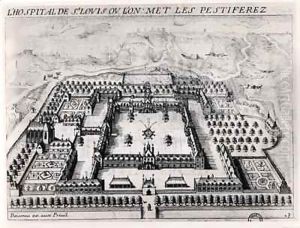Jean Boisseau Paintings
Jean Boisseau was a French cartographer, engraver, and publisher active during the first half of the 17th century, around the time when Paris was becoming a center for cartographic publishing. There is limited information available about Boisseau's early life and training. However, it is known that he was born around the year 1600. His work as a cartographer and engraver placed him among the many artisans and intellectuals in Paris who were contributing to the flourishing of the arts and sciences during this period, known as the Grand Siècle or the 'Great Century' under the rule of Louis XIII and later Louis XIV.
Boisseau is particularly noted for his contribution to the 'Theatre Geographique du Royaume de France,' which is one of the earliest atlases focused specifically on the regions of France. This work was published in 1642 and is considered significant for its detailed representation of the French provinces as they existed during that time. His maps were not only functional but also featured decorative elements that reflected the artistic sensibilities of the Baroque period, with elaborate cartouches and ornate details.
In addition to his geographical works, Boisseau was also known for producing panoramic views and plans of cities, as well as historical scenes and portraits. His engravings were often based on the works of other artists, which was a common practice of the time.
Despite the artistry and craftsmanship of Boisseau's work, he did not achieve the lasting fame of some of his contemporaries, such as Nicolas Sanson, who is often referred to as the father of French cartography. Nonetheless, Boisseau's contributions to cartography and engraving are recognized by historians and collectors, and his maps and engravings are valuable for the insights they provide into the geography and aesthetics of 17th-century France.
Jean Boisseau's death is recorded as having occurred in 1650. His works continue to be of interest to collectors and historians not only for their aesthetic value but also for the historical perspective they offer on France during the Ancien Régime.
